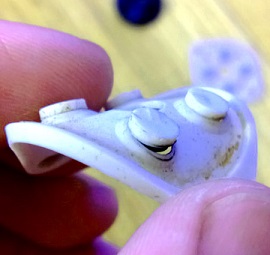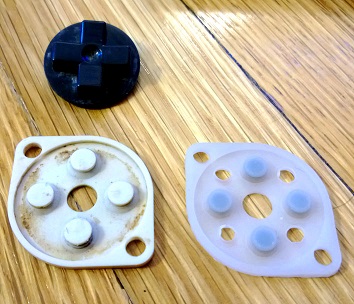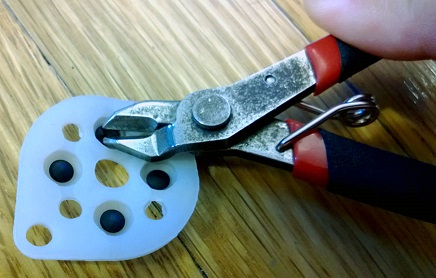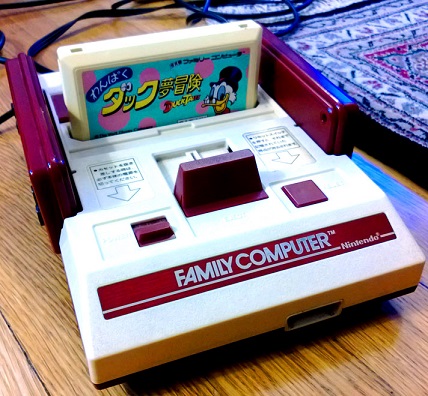 For many years after Nintendo has stopped producing NES and Famicom controllers, people have found that their buttons get worn out and do not work as well as they used to. The problem is typically one of two things: the contacts are dirty, and the rubber pad responsible for all of the springing action inside the controller has cracked.
For many years after Nintendo has stopped producing NES and Famicom controllers, people have found that their buttons get worn out and do not work as well as they used to. The problem is typically one of two things: the contacts are dirty, and the rubber pad responsible for all of the springing action inside the controller has cracked.Problem # is easy to fix: isopropyl rubbing alcohol on both the rubber pad and the controller PCB's contact points will get the nasty dirt off of there (and can also be used to fix a humming Famicom microphone slider on controller #).
Unfortunately, the rubber pads problem is a much larger one. Here is what a very old pad may look like (warning: graphic)
 The good news is that not long ago someone started producing replacement pads. Brand new ones! The "solution" for a long time was to steal parts from pads that are still good, or get a new controller. For users of the Japanese Famicom system, this meant stealing the less-used Player 2 D-pad and buttons. However, as of today, finding such a thing is not as easy as it used to be.
The good news is that not long ago someone started producing replacement pads. Brand new ones! The "solution" for a long time was to steal parts from pads that are still good, or get a new controller. For users of the Japanese Famicom system, this meant stealing the less-used Player 2 D-pad and buttons. However, as of today, finding such a thing is not as easy as it used to be.Here is a comparison of the old crusty pad I am replacing, and the brand new one.
 Immediately concerns are raised about build quality; it is clear that the cutting process for those minor cost-saving holes in the pad is not very accurate. Still, it is brand new, and better than what we had before... right?
Immediately concerns are raised about build quality; it is clear that the cutting process for those minor cost-saving holes in the pad is not very accurate. Still, it is brand new, and better than what we had before... right?I installed it, with great expectations.
Those expectations were dashed swiftly, with the coldness and precision that only a heartless, cheap-goods factory manager is able to procure.
Performance was pitiful. I have tried cleaning it, even applying abrasion to the PCB contacts to no avail. You have to mash the pad in for it to register a direction. This is worse than the old one!
The issue does not lie in build quality. No, it is rather a massive design failure. Whether or not it was done this way out of sheer ignorance, or cost saving somehow, I do not know, but the d-pad hardly registers. The reason is simple: the original contacts were flat, to hit the PCB evenly, while the new ones are rounded, which means only the very tip makes contact unless you mash it in, which makes it squish down.
 Fortunately, I took a break at this point and got a nice cool drink...
Fortunately, I took a break at this point and got a nice cool drink......of water - I am only 20.
I then thought that a solution must be found - my Famicom controllers won't last forever with their current pads and new replacements must be possible. I have found a very good solution that makes the pad feel good as new. Using a pair of diagonal cutters, I have cut out just the very center of the contact pad. This way, the bulge of the rounded pad is not so pronounced, and the pad connects to the PCB in somewhat of a doughnut shape, which does a much better job.


Until someone produces better replacements, this is a suitable way to make do with what we have. The A/B buttons and start/select pair were totally fine, so fortunately there are no complaints there. Now it is time for this Famicom to live an additional thirty years!

Back to main index